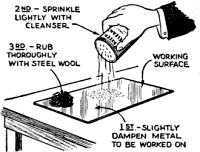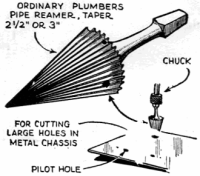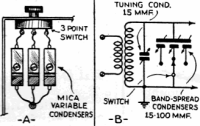|
November 1935 Short Wave Craft
 [Table
of Contents] [Table
of Contents]
Wax nostalgic about and learn from the history of early electronics. See articles
from Short Wave Craft,
published 1930 - 1936. All copyrights hereby acknowledged.
|
Here is a handy-dandy
baker's
dozen of 'kinks,' otherwise known as tricks of the trade, shortcuts, or clever ideas, that could
prove useful while working in the lab at work or in your shop at home. One suggestion
is to place a sheet of tracing paper over your schematic while wiring a circuit
and draw each connection as it is completed, rather than mark up the original drawing.
That was definitely good for a time when making a spare copy of a magazine page
or assembly instruction from a kit was not as simple a matter as it is today. Whether
it be a schematic or a set of plans for a model airplane, I always make a copy to work and draw notes on
rather than defacing the original.
$5.00 for Best Short Wave Kink
 The Editor will award a five dollar prize
each month for the best short-wave kink submitted by our readers. All other kinks
accepted and published will be awarded eight months' subscription to Short Wave
Craft. Look over these "kinks" and they will give you some idea of what the editors
are looking for. Send a typewritten or ink description, with sketch, of your favorite
short-wave kink to the "Kink" Editor, Short Wave Craft. The Editor will award a five dollar prize
each month for the best short-wave kink submitted by our readers. All other kinks
accepted and published will be awarded eight months' subscription to Short Wave
Craft. Look over these "kinks" and they will give you some idea of what the editors
are looking for. Send a typewritten or ink description, with sketch, of your favorite
short-wave kink to the "Kink" Editor, Short Wave Craft.
First Prize $5.00
Simplifying Radio Construction
 I wish to offer the following short-wave
kink which has proved to be or great value to me and is, as far as I know, an original
idea. I wish to offer the following short-wave
kink which has proved to be or great value to me and is, as far as I know, an original
idea.
Take a piece of ordinary tracing paper and lay it over the diagram or blue-print
from which you are hooking up a receiver. As each connection is made, mark it with
a pencil on the tracing paper. When the diagram on the tracing paper corresponds
with the original, you know the set is correctly wired. This eliminates a lot or
hunting for "lost" or "forgotten" leads and is invaluable in wiring complicated
"supers" where a short connection may be accidently overlooked.
- John C. Sherard.
Connection Block for Experimenters
 I have found this kink very useful in connecting
head-phones or speakers to experimental sets. When wiring up "bread-board" sets,
one does not always have the phone tip jacks or clips ready to use. The kink described
will do away with this worry. I have found this kink very useful in connecting
head-phones or speakers to experimental sets. When wiring up "bread-board" sets,
one does not always have the phone tip jacks or clips ready to use. The kink described
will do away with this worry.
Holes large enough for the tip jacks are drilled in the Fahnestock clips. The
clips are then fastened to a small wooden platform by the jacks.
- Samuel Peters.
Finishing Panels at Home
 Many set-builders retrain from using low-cost
galvanized iron for chassis or panels because of its finish, but by following these
instructions, they may produce a beautiful satin finish on it. Lay the piece to
be worked on on a flat surface and pour a little water on it. Next, sprinkle a little
Dutch Cleanser or kitchen cleanser on it. and then rub it well with steel wool,
in a circular motion. In about five minutes a very silvery finish will be obtained,
equal to that of aluminum. It may be given a high luster if polished with silver
polish. Many set-builders retrain from using low-cost
galvanized iron for chassis or panels because of its finish, but by following these
instructions, they may produce a beautiful satin finish on it. Lay the piece to
be worked on on a flat surface and pour a little water on it. Next, sprinkle a little
Dutch Cleanser or kitchen cleanser on it. and then rub it well with steel wool,
in a circular motion. In about five minutes a very silvery finish will be obtained,
equal to that of aluminum. It may be given a high luster if polished with silver
polish.
The sketch is enclosed on another sheet. I hope this kink will be acceptable.
- Lloyd Canly, Jr.
Large Reamer for Working Chassis
 I have found this idea of cutting holes
in metal chassis and panels to be better, quicker and easier than any other tool
I know of. I simply use an ordinary plumbers' pipe reamer that has a taper of 1/2
inch to 2 1/2 or 3 inches. I have found this idea of cutting holes
in metal chassis and panels to be better, quicker and easier than any other tool
I know of. I simply use an ordinary plumbers' pipe reamer that has a taper of 1/2
inch to 2 1/2 or 3 inches.
This tool is one that will drill any size hole, while an ordinary one has only
one size, it is also a toot that won't wear out quickly and it will fit an ordinary
brace. It is easy to use and drill neat holes for tube sockets or anything else.
I don't believe a sketch would be necessary as every one knows what a pipe reamer
or countersink is; you have my permission to express my idea in any sketch for the
magazine. I am a reader of Short Ware Craft and find it my favorite radio magazine.
- Leonard J. Ohmes. (An Illustration is given. - Editor)
Wave-Trap Eliminates Interference
 I submit the following kink for entrance
in your monthly contest. I have found it quite useful in S. W. work. I submit the following kink for entrance
in your monthly contest. I have found it quite useful in S. W. work.
This is a wave-trap to overcome interference from a near-by station. The trap
consists of a parallel-connected coil and condenser inserted in the antenna lead
of the set. The coils consist of 72 turns of No. 22 D.S.C. wire on a 3-inch diameter
form. The condenser should be of 0.00025 mf. capacity. Simply tune the set to the
best setting for the desired station.
It may prove necessary to shield the wave-trap if the undesirable station is
very close.
- F. J. Spatz, Jr.
Porcelain Tube Stand-Off Insulator
 Inexpensive stand-off insulators can be
made from ordinary porcelain lead-in tubes. A length of dowel is glued in one end
of the tube and any form of clamp or soldering lug is fastened to this with a screw.
The large end of the insulator is clamped to its support by a small counter-sunk
block of wood and two long bolts or screws. To avoid splitting the tubes, a hole
should be drilled in the end before driving the screw. Inexpensive stand-off insulators can be
made from ordinary porcelain lead-in tubes. A length of dowel is glued in one end
of the tube and any form of clamp or soldering lug is fastened to this with a screw.
The large end of the insulator is clamped to its support by a small counter-sunk
block of wood and two long bolts or screws. To avoid splitting the tubes, a hole
should be drilled in the end before driving the screw.
- Chester Towle.
Coil-Winding Kink
 Here is a simple little kink used when winding
plug-in coils with fine wire. After the coil was wound I found it difficult to lead
the thin wire through the coil prongs. To overcome this difficulty, I took a thin
sewing needle and threaded the end of the coil wire on it, then by pushing the needle
through the prong I could draw the wire after it. The wire was then pulled tight
and soldered. If tube bases are used for coil forms, the solder must first be cleaned
from the prongs so that the needle will slip through easily. Here is a simple little kink used when winding
plug-in coils with fine wire. After the coil was wound I found it difficult to lead
the thin wire through the coil prongs. To overcome this difficulty, I took a thin
sewing needle and threaded the end of the coil wire on it, then by pushing the needle
through the prong I could draw the wire after it. The wire was then pulled tight
and soldered. If tube bases are used for coil forms, the solder must first be cleaned
from the prongs so that the needle will slip through easily.
- Hurley Kauffman.
Simplified Band-Spread
 Today no receiver is really complete without
some arrangement for "band-spreading." This system is not merely a substitute, but
one that I use in preference to the conventional "large condenser" method of band-spreading.
Not only is it possible to construct the receiver on a much smaller base, but by
using this method, one can have a truly "calibrated" receiver. It is no longer necessary
to tune critically for a reference station, for by simply flipping the switch to
one of the three positions, one can find the desired station at exactly the same
position on the dial every time. Today no receiver is really complete without
some arrangement for "band-spreading." This system is not merely a substitute, but
one that I use in preference to the conventional "large condenser" method of band-spreading.
Not only is it possible to construct the receiver on a much smaller base, but by
using this method, one can have a truly "calibrated" receiver. It is no longer necessary
to tune critically for a reference station, for by simply flipping the switch to
one of the three positions, one can find the desired station at exactly the same
position on the dial every time.
- Walter J. Kowalchik.
Handy Tray from Old Tin Can
 After looking all over the place for containers
for nuts, bolts, resistors, etc., I hit upon this idea. Take an old milk can, large
size; cut through as shown on the dotted line, then bend over. This makes a two-compartment
container. Several of these cans may be laid side by side, making very handy trays.
- F. W. Osborn. After looking all over the place for containers
for nuts, bolts, resistors, etc., I hit upon this idea. Take an old milk can, large
size; cut through as shown on the dotted line, then bend over. This makes a two-compartment
container. Several of these cans may be laid side by side, making very handy trays.
- F. W. Osborn.
Home-Made Vernier
 Sometime ago when in the need of a vernier
dial, I hit upon the following idea, which is clearly shown in the drawing. The
only necessary parts are an old dial, some string or fish cord, a spool, and a short
length of metal strip. The knob of the regular dial should be grooved for the fish
cord. The metal is formed as shown in the drawing and fastened below the mounting
board on which the condenser is fastened. Sometime ago when in the need of a vernier
dial, I hit upon the following idea, which is clearly shown in the drawing. The
only necessary parts are an old dial, some string or fish cord, a spool, and a short
length of metal strip. The knob of the regular dial should be grooved for the fish
cord. The metal is formed as shown in the drawing and fastened below the mounting
board on which the condenser is fastened.
Another advantage of this system is the total absence of "body-capacity" effects,
because the hand is so far removed from the condenser.
- Claude E. Longstreth.
Aligning Tool for Fine Tuning
 Here's a kink I find very satisfactory for
eliminating "body-capacity" where an insulated shaft coupling is not available.
Remove the knob from the front of a vernier dial and file a slot in the shaft to
fit the end of a trimmer condenser tool. This being insulated, gives very good results
in eliminating "hand" capacities. It is especially adjustable to ultra-short wave
receivers. where hand capacities are annoying. Here's a kink I find very satisfactory for
eliminating "body-capacity" where an insulated shaft coupling is not available.
Remove the knob from the front of a vernier dial and file a slot in the shaft to
fit the end of a trimmer condenser tool. This being insulated, gives very good results
in eliminating "hand" capacities. It is especially adjustable to ultra-short wave
receivers. where hand capacities are annoying.
- J. R. Blundin.
Voltage-Doubling Power Supply
 Here is a simple method of obtaining a high
voltage "B" supply without the use of a power transformer. A couple of 27s are made
to double the voltage and rectify it at the same time. The output voltage depends
on the value of the condensers X and Y, which should be from 4 to 8 mf. Although
this kink is not original, I do not recall having seen it in Short Wave Craft. Here is a simple method of obtaining a high
voltage "B" supply without the use of a power transformer. A couple of 27s are made
to double the voltage and rectify it at the same time. The output voltage depends
on the value of the condensers X and Y, which should be from 4 to 8 mf. Although
this kink is not original, I do not recall having seen it in Short Wave Craft.
- Jerome Farmer.
Coil Handle
 My plug-in coils are fixed as shown in above
drawing. Then use sandpaper to roughen the top edge of the coil; next cement a poker
chip with glass knob fastened through hole in top to the coil. This is very handy
when changing coils, and does not injure the coil windings. My plug-in coils are fixed as shown in above
drawing. Then use sandpaper to roughen the top edge of the coil; next cement a poker
chip with glass knob fastened through hole in top to the coil. This is very handy
when changing coils, and does not injure the coil windings.
- Charles F. Deane.
Posted February 24, 2020
(updated from original post on 8/2/2015)
|










































